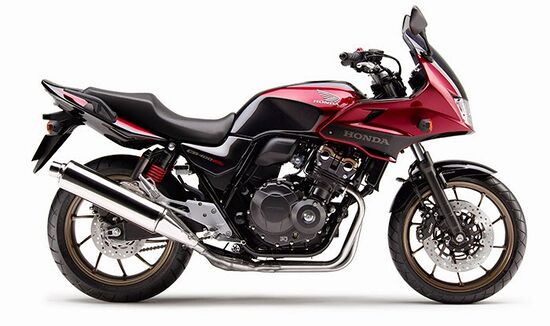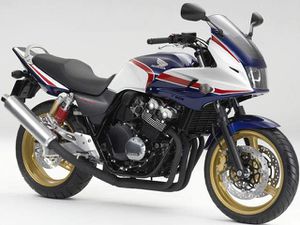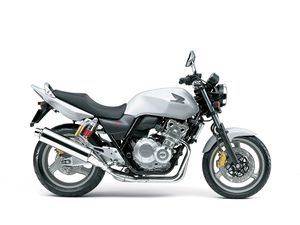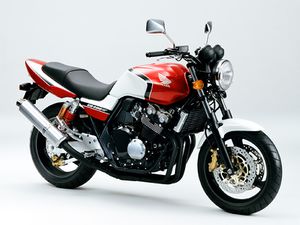The legendary classic motorcycle "Honda CB 400 Super Four" began its history in 1992, replacing the model Honda CB-1, which was not widely used in those years. The new Honda CB 400 had more familiar classic features - a steel duplex frame, a traditional single steering wheel (instead of a clip-on), a double shock at the rear (instead of a monoshock), a classic tank and seat shape, and dual disc brakes at the front.
However, the main feature of the Honda CB 400 was the engine, which, despite the small volume of 399 cc. see, proved to be the most reliable among all similar motorcycles from other Japanese manufacturers. The engine was liquid cooled, 16 valves and 2 camshafts, and produced the traditional 53 hp. power and 38 Nm of torque. Like all Japanese inline-fours, the Honda CB400SF engine was high-revving, with maximum performance in the 9500-11000 rpm range.
The Honda CB 400 model is a domestic Japanese motorcycle and is officially supplied only to the Australian market (since 2008). However, this fact does not prevent CB400 from being sold all over the world, thanks to the efforts of importing firms.
Also noteworthy is the fact that the Honda CB 400 continues to be produced and officially marketed today as the main training bike in most Japanese motorcycle schools. The reputation of a simple, reliable, unpretentious and perfectly controlled motorcycle made this model the most preferred option for the first motorcycle not only in the Russian Federation, but also around the world.
Major generations of the Honda CB 400 Super Four:
- Honda CB400SF (1992-1998) - the first generation of the motorcycle.
- Honda CB400SF (1999-2001) - the second generation of the motorcycle. Spec I marking. This modification has a slightly more modern appearance and the presence of the Hyper Vtec system.
- Honda CB400SF (2002-2003) - the third generation of the motorcycle. Spec II Marking. This modification is slightly different in appearance, has a built-in immobilizer (HISS) and a reconfigured Hyper Vtec system.
- Honda CB400SF (2004-2007) - the fourth generation of the motorcycle. Spec III Marking. This modification has significant differences in appearance and reconfigured Hyper Vtec system.
- Honda CB400SF Boldor (2004-2007) - the version is completely similar to the previous one, but has a front fairing.
- Honda CB400SF Revo (2008-present) - the version is similar to the fourth generation, but has different colors and silvery engine covers and rims.
- Honda CB400SF Revo Boldor (2008-present) - version similar to the fourth generation Boldor version, but with silver engine covers and rims.
The main competitors of the Honda CB400 in the class:
Photos
Specifications
Specifications Honda CB 400 Super Four:
| Model | Honda CB 400 Super Four |
|---|---|
| Motorcycle type | Road (street, naked) |
| Release year | 1992+ |
| Frame | steel tubular |
| Engine type | 4-cylinder, 4-stroke, in-line |
| Working volume | 399 cc cm. |
| Bore / stroke | 55.0mm x 42.0mm |
| Compression ratio | 11.3: 1 |
| Cooling | liquid |
| Number of valves per cylinder | DOHC, 4 valves per cylinder |
| Fuel supply system | carburetor, 4x Keihin CV 32 mm - CB400 NC31-39
injector, PGM-FI - CB400 NC42 |
| Ignition type | fully transistor |
| Maximum power | 53 hp (39 kW) at 11000 rpm - CB400 NC31-39
53 h.p. (39 kW) @ 12000 rpm - CB400 NC31 Version R 53 h.p. (39 kW) @ 10,500 rpm - CB400 NC42 |
| Maximum torque | 36 Nm (3.7 kgm) @ 10,000 rpm - CB400 NC31
38 Nm (3.9 kgm) @ 9500 rpm - CB400 NC39-42 |
| Gearbox | 6-speed |
| Drive type | chain |
| Front tire size | 110 / 70-17 54H - CB400 NC31
120 / 60ZR17M / C 55W - CB400 NC39-42 |
| Rear tire size | 140 / 70-17 66H - CB400 NC31
160 / 60ZR17M / C 69W - CB400 NC39-42 |
| Front brakes | 2 discs 296mm, 2-piston calipers - CB400 (1992-1995)
2 discs 296 mm, 4-piston calipers - CB400 (1996+), ABS (2008+) |
| Rear brakes | 1 disc 240mm, 1-piston caliper, ABS (2008+) |
| Front suspension | 43mm telescopic fork, 120mm travel |
| Rear suspension | Double shock absorber (preload adjustment), 110mm travel |
| Length | 2085 mm - CB400 NC31
2080 mm - CB400 NC31 Version R, CB400 NC42 2040 mm - CB400 NC39 |
| Width | 720 mm - CB400 NC31
735 mm - CB400 NC31 Version R 725 mm - CB400 NC42, CB400 NC39 |
| Height | 1080 mm - CB400 NC31, NC42
1125 mm - CB400 NC31 Version R 1070mm - CB400 NC39 1160 mm - CB400 NC42 Boldor |
| Wheelbase | 1455 mm - CB400 NC31
1450 mm - CB400 NC31 Version R 1415 mm - CB400 NC39 1410 mm - CB400 NC42 |
| Saddle height | 770 mm - CB400 NC31
775 mm - CB400 NC31 Version R 760 mm - CB400 NC39 755 mm - CB400 NC42 |
| Acceleration to 100 km / h | 4.5 sec |
| Maximum speed | 180 km / h (limiter) |
| Fuel tank capacity | 18 l |
| Motorcycle weight (dry) | 173 kg - CB400 NC31, CB400 NC42 Boldor
175 kg - CB400 NC31 Version R 168 kg - CB400 NC39 170 kg - CB400 NC42 |
| Motorcycle weight (curb) | 193 kg - CB400 NC31
195 kg - CB400 NC31 Version R 189 kg - CB400 NC39 197 kg - CB400 NC42 200 kg - CB400 NC42 Boldor |
Fuel consumption
Fuel consumption on the Honda CB 400, as well as on other models, is highly dependent on the riding style and technical condition of the motorcycle. On average, petrol consumption ranges from 4-5 liters at a moderate driving speed to 8 liters with a particularly dynamic driving. The official consumption value (at 60 km / h) is 2.88-3.22 liters per 100 km.
Documentation



